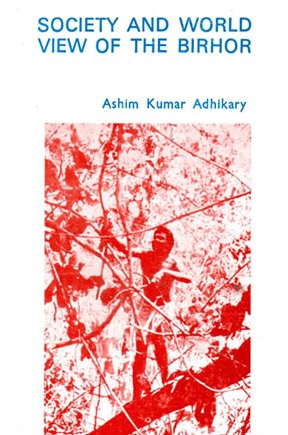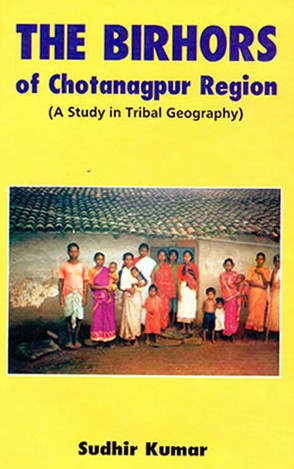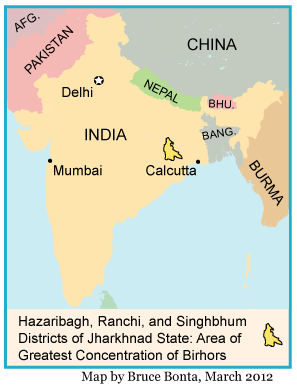Location. A forest-dwelling society of 10,726 people in 2011, who live in central and eastern India in the states of Orissa, Chhattisgarh, West Bengal, and Jharkhand with the greatest concentration in the Ranchi, Hazaribagh, and Singhbhum districts of Jharkhand. Several recent reports have indicated that the population may have dropped to 4,000 people. The Birhor themselves are concerned about their declining numbers.

Economy. The traditional Birhor economy has been based on nomadic gathering, hunting, particularly for monkeys, and making ropes out of the fibers of a particular species of vine, which they sell in the markets of the nearby agricultural peoples. The Birhors are the primary suppliers of ropes to the peasant communities, so both groups depend on one another and have a stable exchange relationship. But the Birhor have been quite disrupted in recent decades due to deforestation and government attempts to settle them into permanent agricultural villages. Despite decades of resettlement efforts, they still abandon their settlements early in the morning to wander in what’s left of their forests, only to return mostly empty handed in the evenings. Numerous news reports from India have focused on the extreme poverty of the Birhor, such as an analysis of the tragic deaths of Birhor people in a remote village; their precarious food situation; the lack of results from government assistance programs; and the relief that the very poor people sometimes find in pleasurable activities.
Beliefs that Foster Peacefulness. Many Birhor beliefs are based on the needs of their society. For instance, according to one of their legends a Birhor man once discovered a rich supply of creepers perfect for making ropes for an entire year, but instead of hoarding the knowledge, he quickly returned to his settlement to tell everyone. Such myths encourage people to share their resources. The Birhor also believe in harmonizing their lives with natural forces—they love being in the forest. When they encounter poisonous snakes near their camps, the adults simply try to shoo them off like pets. They react with respect toward the larger animals, and blame themselves for their fears if they are attacked. Their name for themselves, “Birhor,” means “men of the forest.”
Avoiding and Resolving Conflict. Disputes among the Birhor may be resolved by councils of elders from neighboring settlements. In one case, for example, a man’s wife eloped with another man; the council settled the matter by ruling that the new man had to repay the aggrieved husband for the value of his gifts to the woman when they were married. In rare cases when a factional dispute threatens a settlement, people simply split into two camps. A 2015 news story reported that the headmen in Birhor villages will now handle people who violate rules that prohibit getting into fights by fining them a few bottles of their rice beer.

Gender Relations. The Birhor family is a cooperative economic and cohesive social unit. The wife is responsible for cooking, child-raising, and selling to nearby villages the ropes that the men make from vines in the forest. While the Birhor permit divorce and remarriage, both are rare. When a couple has a dispute, they may bring it to the headman of the group who makes a binding decision as to whether a divorce is warranted. One headman indicated that he had never had a case, such as adultery, that would be serious enough to cause a divorce. Couples appear to be quite loving and faithful. Recent news stories indicate that Birhor women can become activists, such as an instance in 2013 of their protesting against a mining permit.
Raising Children. Parents have affectionate relationships with their children and rarely become angry with them. Boys and girls help their fathers and mothers with their respective tasks. Siblings also have close relationships, perhaps the closest in Birhor society. Elder brothers care for younger siblings in the absence of their fathers, while the younger ones look up to older brothers for their experience and wisdom. These highly pervasive sibling relationships tend to last after marriage, as families frequently continue to live and move together.
Sense of Self. The folksongs of the Birhor establish the importance of human relationships to nature, the spirits, other humans, and the self. Songs evoke the beauty of their forested environment, the relaxed Birhor attitude toward marriage and divorce, their love for their spouses, their enjoyment of hunting, and their appreciation for flowers, rivers, mountains and wild deer. One song recounts a legendary fight that resulted in a lot of bloodshed, the narration of which freshens Birhor dread for violence. Others highlight their customary hospitality and their concern for streams free of pollution.

Cooperation and Competition. When the Birhor hunt monkeys in the forest, they do it in a cooperative manner with a large group of people to drive the animals into the nets. While everyone receives a share of the meat, the owner of the nets that successfully trapped the monkeys gets the largest portion plus the skin, which he might be able to sell. The successful hunter divides the game, though he must follow established customs in assigning fair portions. The Birhor are despised by the Hindu peoples because they eat the flesh of monkeys, but at the same time they are admired by other tribal societies because they can live so successfully in the forest.
Strategies for Avoiding Warfare and Violence. The Birhor are looked down upon by the low-caste Hindu peasants who live around them. They accept their lower status and manage their neighbors’ impressions effectively, yet they adopt some of the Hindu ideas in order to keep relations stable. They cultivate their reputation among the farmers as experts in religious magic, which is based on their knowledge of the forests. Their relationships with the settled peasants are generally free of violence because the Birhor carefully control relationships, maintain a social distance, and focus their forest-based economy so it does not interfere with the gathering activities of the farming peoples. They solve difficult situations with their neighbors by moving to new locations.
But How Much Violence Do They Really Experience? The Birhor are honest, peaceful people who seldom fight among themselves, avoid conflicts with villagers, and are “never involved in any crimes,” according to Bhattacharyya (1953). However, a Birhor woman reported to the police in 2013 that she had been gang raped by four men, one of whom was a Birhor.
More Resources in this Website:
- A community in Jharkhand state, terrorized by an aggressive bee swarm, approached some nearby Birhor for help in getting rid of the insects.
- A display of Birhor crafts at a trade fair in northeast India in 2012 was a hit with fairgoers.
- Some Birhor are learning how to fabricate dinner plates commercially out of forest leaves.
Sources in Print: Adhikary 1984a, 1984b, 1999; Bhattacharyya 1953; Chakraborty 1982; Sarkar 1980; Sinha 1972
Sources on the Web: Adhikary 1995
Updates—News and Reviews:
Selected Recent Stories
January 7, 2016. A Birhor Celebration
January 15, 2015. Update on a Birhor Tragedy
July 17, 2014. Official Concern for Birhor Wanes
April 24, 2014. Birhor Boycott National Elections
All Stories
All stories in this website about the Birhor are listed in the News and Reviews Subject Listing
